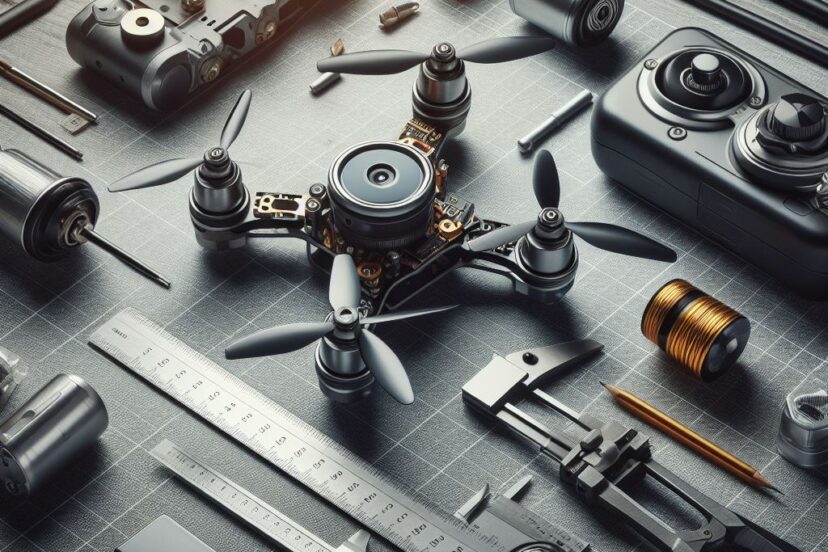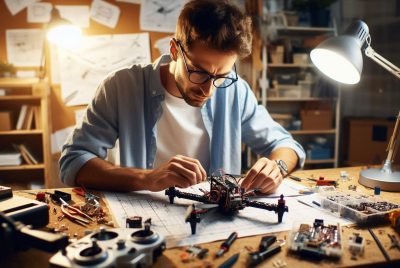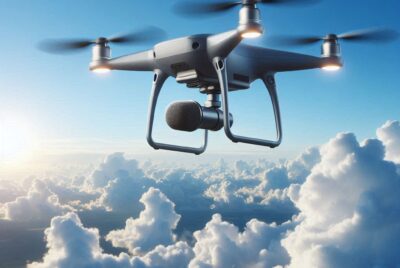Drone Parts: Exploring the Backbone of Aerial Technology
*We may earn a commission for purchases made using our links. Please see our disclosure to learn more.
Drone Parts: Essential Components for Maintenance and Repair
In the ever-evolving world of technology, drones have soared to prominence both as tools for leisure and critical instruments in various industries. My understanding of drones extends to their multifaceted applications, ranging from aerial photography to agriculture, search and rescue operations, and even to the delivery of goods. The backbone of these versatile machines lies in drone parts and accessories, each component meticulously designed to provide functionality and performance. In the industry, the quality and compatibility of these parts are paramount for the operation of both hobbyist and professional drones.

Drone enthusiasts and professionals alike continually seek out parts that can either enhance the capabilities of their UAVs (Unmanned Aerial Vehicles) or serve as replacements in the event of wear or damage. Whether it’s frames that offer durability and reduced weight, motors that provide the thrust needed to navigate the skies, or gimbals that stabilize cameras for that perfect shot, each component plays a crucial role. By understanding the importance of these parts, I ensure that my drone maintains top performance and stays updated with the latest advancements in drone technology.
Navigating the market for drone parts, one will find a plethora of options tailored to different models and specifications. It’s crucial to sift through these choices with an informed eye, understanding that parts from trusted manufacturers and suppliers can make or break the experience of piloting a drone. As the industry grows, so does the availability of parts, and staying informed about the best sources and the most reliable components has become a significant aspect of engaging with drone technology.
Understanding Drone Components

When it comes to building or maintaining a drone, knowing the purpose and function of each component is critical. This knowledge ensures quality repairs, precise tuning, and optimal performance.
Motor Types and Functions
The motors are the heartbeat of the drone, providing the necessary thrust to elevate and maneuver it through the air. There are typically two types of motors found in drones: brushed and brushless. Brushed motors are more affordable but have a limited lifespan, while brushless motors boast durability and efficiency. Each motor rotates either clockwise (CW) or counterclockwise (CCW) to balance the drone’s propulsion, with their spinning direction controlled by electronic speed controllers (ESCs).
Flight Control and Stabilization Systems
My drone relies on an intricate flight control system to stay airborne, which includes an array of sensors and a GPS module. This system processes inputs from the compass and sensor array to stabilize the drone, while ESCs play a critical role by adjusting the speed of each motor to maintain balance.
Power Supply and Management
The intelligent flight battery is the power source of my drone, which connects via cables to a power board. Managing this power supply is crucial; thus, a reliable cooling fan is often integrated to prevent overheating. It’s imperative to use quality parts for replacements to ensure longevity and safe flying conditions.
Propulsion and Aerodynamics
Propulsion is achieved through propellers which cut through the air, and their design is a study in aerodynamics. I ensure that the propellers are free from damage and securely attached using the appropriate screws. For aerodynamic efficiency, both standard and pusher propellers need to be balanced and made of high-quality materials.
Communication Systems
The communication between my drone and the controller is vital, which is why the video transmitter, antenna, and FPV camera must function flawlessly. These components work in tandem to deliver real-time video, and I ensure the cable set and connections are secure for uninterrupted communication. Wearing goggles provides an immersive experience and precise control during FPV flights.
Structural Integrity and Repair
Maintaining the structural integrity of my drone includes regular checks on the bottom shell, gimbal vibration absorbing bracket, and other structural components. I keep a tool kit handy—preferably from reputable sources like iFixit—for any necessary fixes. In case of damages, I opt for high-quality replacement parts to maintain performance and extend the lifespan of my drone.
Popular Drone Models and Their Specifics

In this section, I’m going to dive deep into some of the most renowned drone models from various manufacturers. I’ll discuss the specifics and attributes that make each model stand out in the industry.
DJI Drone Series Overview
DJI is one of the leading manufacturers in the drone industry, known for its high-quality and innovative products. Models like the DJI Phantom 4 and the Inspire 1 have set benchmarks for aerial photography and videography. The Phantom 4 is celebrated for its stable flight and precision controls, while the Inspire 1 is renowned for its advanced camera and gimbal system.
Autel and Other Manufacturers
While DJI has a substantial market share, other manufacturers like Autel Robotics also make their mark. Autel is based in the USA and offers drones that are often seen as being highly compatible with user needs, boasting models like the Autel EVO series which competes closely with DJI’s offerings.
Comparing Mavic and Spark Series
The DJI Mavic series, including the Mavic Pro, DJI Mavic 2, and the DJI Mavic Air, offers a blend of portability and performance. Compared to the DJI Spark, known for being user-friendly and compact, the Mavic series provides more advanced features and higher resolutions with a higher price tag. The Mavic Pro is especially prominent for offering a balance between functionality and size.
In-Depth Look at the Air 2 Drone
Focusing on the DJI Mavic Air 2, this drone is a powerhouse in a small footprint. It features significant improvements over the original Mavic Air, including longer flight time and better camera capabilities. The Air 2 captures stunning 48MP photos and 4K/60fps video, leveraging advanced technologies like obstacle sensors and intelligent shooting modes. It’s an exemplary model showcasing the evolution of drone technology.
Drone Accessories and Enhancements

When discussing drone accessories and enhancements, I focus on three key areas that significantly uplift the drone flying experience: vision enhancement through quality goggles, power management with advanced batteries, and personalization via customization kits.
Vision Enhancement and Goggles
For immersive flight experiences, goggles paired with a first-person view (FPV) camera offer real-time visuals, mimicking the feeling of flying. Quality goggles can transform my flight, granting me a bird’s-eye view that is fully compatible with my drone’s camera system. The clarity and responsiveness of these goggles usually depend on the resolution and refresh rate they feature.
Extended Flight with Better Batteries
The intelligent flight battery is a game-changer, engineered to provide longer flight times and more robust power management. By utilizing these improved batteries, I can extend my flight sessions substantially. High-quality, compatible batteries are crucial since they also come with smart features like integrated power management and status monitoring, which prevent overcharging and excessive discharge.
Customization with Accessory Kits
Accessory kits allow for a high degree of customization. From different propellers that can enhance lift and efficiency, to specialized cable sets for unique flight control configurations, these kits help me tailor my drone to specific needs or regulations. By carefully selecting accessories featured in these kits, I ensure each part works in harmony with my drone, maintaining or even improving its original performance specs.
Maintenance and Troubleshooting
\In maintaining and repairing drones, I focus on regular diagnostics, clear repair guides for frequent issues, and accurate methods for sourcing and installing the right replacement parts.
Routine Check-Ups and Diagnostics
I make it a habit to perform routine check-ups and diagnostics on my drone to prevent potential issues. This involves:
- Inspecting the motor: I ensure that both clockwise (CW) and counterclockwise (CCW) motors are free of debris and that their cooling fans work properly.
- GPS Module: I check the GPS module for secure mounting and clear signal reception.
- Battery checks: For optimal performance, I monitor battery health and maintain proper charging cycles.
Repair Guides for Common Issues
When encountering common drone problems, I rely on step-by-step repair guides. Some issues I address include:
- Power Problems: Using a multimeter, I check for electrical continuity and resolve power distribution issues.
- Unstable Flight: I inspect propellers for damage and ensure they are screwed in tightly.
- GPS Signal Loss: I refer to the drone’s manual or an iFixit guide for troubleshooting.
- Image Quality: For camera-related issues, I clean the lens and check the connections.
Finding and Installing Replacement Parts
To fix my drone, I must source the correct replacement parts. My approach involves:
- Identifying the specific part needed (e.g., motor, screws, GPS module).
- Locating a reputable supplier or an online marketplace like eBay where I can find good deals on parts.
- Following a reliable guide or tutorial for installation.
By tackling maintenance and troubleshooting systematically, I keep my drone in top flying condition.
Frequently Asked Questions

In this section, I cover some of the most common inquiries about drone parts and their functions, from what’s included in a repair kit to choosing the right upgrades for your drone.
1. What components are typically included in a drone repair kit?
Most drone repair kits will include a variety of fasteners, propellers, motor gears, and screwdrivers. Some might also provide spare motors and propeller guards depending on the kit’s comprehensiveness.
2. How can I identify different parts on a drone diagram?
On a drone diagram, parts such as motors, ESCs (electronic speed controllers), propellers, and the flight controller are typically labeled. I recommend studying the drone’s manual for a detailed diagram and description for accurate identification.
3. What are the essential parts required to build a FPV (First Person View) drone?
Building an FPV drone requires essential parts like a frame, motors, propellers, a flight controller, ESCs, a power distribution board, FPV camera, video transmitter, and a receiver for the controller.
4. Where can I find replacement parts for a DJI drone model?
Replacement parts for a DJI drone model can be found on DJI’s official website or at authorized retailers. There are also third-party vendors that specialize in drone repairs and parts.
5. What accessories are available to enhance drone functionality?
Accessories such as additional sensors, improved battery packs, or specialized cameras can enhance a drone’s functionality. Payload delivery mechanisms and brushless water pumps are examples of specific add-ons for drones in different applications.




